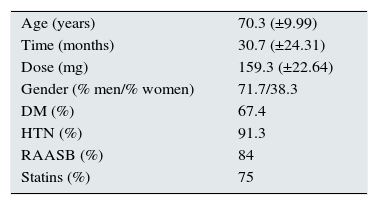Hyperlipidaemia is a widespread health problem in the general population; it needs to be treated to achieve a reduction of cardiovascular risk factors and therefore morbidity and mortality,1 this consideration is more important in renal patients, as they already present a high cardiovascular risk.2 Thus, in these patients, the use of fibrates to control hypertriglyceridemia is common,3 but this can lead to additional problems; it is well known the relationship between the use of fibrates and impaired kidney function.1,3 We collected 46 cases of kidney failure, associated with treatment with fenofibrate, that occurred at our centre and in which the impaired kidney function could only be attributed to the initiation of treatment with this drug. Changes in kidney function before and after starting the drug, and after its withdrawal were analysed. Changes in proteinuria after discontinuation of the drug were also documented. All patients had chronic kidney disease (CKD) stages II–IV. There were 71.7% of men and 84.8% were receiving drugs that block the renin–angiotensin–aldosterone system (RAAS) and 73.9% were on statins. Mean treatment time was 30.7 months (±24.31), and the mean dose was 159.3mg (±22.64). There were 67.4% diabetics and 91.3% hypertensive (Table 1). Mean plasma creatinine (Cr) increased from 1.4mg/dl (±0.37) to 2.0mg/dl (±0.48), after starting fibrates. Two months after discontinuation of the drug the serum Cr decreased to 1.4mg/dl (±0.33). This value of Cr was maintained over 12 months, with mean of 1.4mg/dl (±0.42) (Table 2). Glomerular filtration rate (GFR), estimated by the CKD-EPI equation, increased from 33.6ml/min (±10.17), when the drug was discontinued, to 51.3ml/min (±19.22) a year after it was stopped. Two months after discontinuation of the drug the albumin/creatinine ratio (ACR) increased from 338mg/g (±774) to 893mg/g; but, after 12 months this initial increase disappeared, and the urine ACR was 309mg/g (±676). Cases in which the impaired kidney function could have been related to other nephrotoxic agents or associated factors, that could reduce GFR were excluded; and, it became evident that there was a clear temporal relationship between impaired kidney function and the initiation of treatment with fenofibrate, as well as recovery after stopping fenofibrate.3 This association has been describe in the literature4,5 in patients with normal kidney function and in those with kidney failure, but the present incidence is not known.6 As a pathophysiological mechanism, it has been linked to a decreased production of vasodilator prostaglandins and a possible natriuretic effect that might cause vasoconstriction of the afferent arteriole and RAAS activation.1,7 Of the cases collected, 84% were receiving RAAS-blocking drugs. It has been reported that kidney failure associated with the use of fibrates is more common when drugs that affect renal haemodynamics are used simultaneously.4,7 Other proposed reason for the elevation of blood creatinine is increased creatinine production due to accelerated cell lysis2 plus a decreased tubular secretion.3 In our series, neither liver enzymes nor creatine kinase were elevated. In conclusion, these cases represent patients in whom impaired kidney function was only attributable to fibrates. This is not a systematic review of all cases in which treatment with these drugs was started, and therefore the incidence of drug-associated kidney failure was not analysed. The relationship between kidney failure and the use of fibrates is clear; thus, kidney function should be closely monitored in patients that starts treatment with these types of drugs.
Characteristics of the population studied.
| Age (years) | 70.3 (±9.99) |
| Time (months) | 30.7 (±24.31) |
| Dose (mg) | 159.3 (±22.64) |
| Gender (% men/% women) | 71.7/38.3 |
| DM (%) | 67.4 |
| HTN (%) | 91.3 |
| RAASB (%) | 84 |
| Statins (%) | 75 |
RAASB: renin–angiotensin–aldosterone system blockers; DM: diabetes mellitus; HTN: hypertension.
Evolution of serum creatinine, glomerular filtration rate (CKD-EPI) and proteinuria in relation to the initiation and discontinuation of fenofibrate.
| Variable | Before fibrate | With fibrate | Two months after discontinuation of fibrate | Twelve months after discontinuation of fibrate |
|---|---|---|---|---|
| Cr (mg/dl) | 1.4±0.37 | 2.0±0.48 | 1.4±0.33 | 1.4±0.42 |
| GFR (ml/min) | – | 33.6±10.17 | 47.9±15.36 | 51.3±19.11 |
| Urine ACR (mg/g) | – | 338.01±773.88 | 839.0±1603.19 | 309.0±676.60 |
Cr: creatinine; GFR: glomerular filtration rate; ACR: albumin/creatinine ratio.
Please cite this article as: Cobelo Casas CR, Millán Díaz B, González Tabarés L, Gómez Larrambe N, Cabezas González L, García Merino ML, et al. Insuficiencia renal asociada al uso de fibratos (n=46). Nefrologia. 2017;37:216–217.








